ISSN ONLINE(2319-8753)PRINT(2347-6710)
ISSN ONLINE(2319-8753)PRINT(2347-6710)
| Prof.Nilamkumar S Patel, Prof.Reepen R Shah, Mr.Nisarg M Patel, Prof.J.K.Shah, Mr.Sharvil B Bhatt Assistant Professor, Department Of Mechanical Engineering, Silver Oak College Of Engineering And Technology, Ahmedabad, Gujarat, India1,2,4 B.E.[Mechanical] Student, Department Of Mechanical Engineering, Silver Oak College Of Engineering And Technology, Ahmedabad, Gujarat, India3,5 |
| Related article at Pubmed, Scholar Google |
Visit for more related articles at International Journal of Innovative Research in Science, Engineering and Technology
In this review paper comparision of different solar stills which are stepwise basin solar still, pyramid solar still and concave/convex basin solar still are taken with its different parameters(glass thickness, glass and water temp difference, absorber plate area, and free surface area of the water these will affect productivity and efficiency of the solar still, due to different designs of solar still, its parameter changes and to find out that which one is the bestest designs compare to others.
Keywords |
| pyramid type solar still, step wise basin solar still, concave basin, efficiency, productivity |
INTRODUCTION |
| Solar energy seems to be very promising source, although now a days only 0.4% energy is utilized in generation of electricity but as it is used in some other applications like solarstills, solar water heater, solar cooker, solar pump etc.. |
| Solar still is the one of the instrument which is generally used to convert the brackish water in to usable (drinkable) water, solar still have basin which is have different designs, In the actual process due to heating of water it undergoes phase change and vaporization is occurred then, vapour rises and comes into cooler transparent, inclined surface and here vapour once again undergoes phase change . the water then condensed and runs in to collecting channel, which is made of galvanized steel. The main factor for condensation process In solar still is difference between glass temp. and water temp. as the difference is more the speed of condensation is increases which is studied by v. velmurugan. K. srithar [14]the distilled water does not contain any dissolved solid like calcium carbonates so, it is safer than thepasturised water. |
| The effect of glass cover thickness increases the productivity which is studied by dr. P. K. shah and Hitesh N. Panchal et al [15] and conclude that lower glass cover thickness distillate output from solarstill 4mm glass cover thickness produces more distillate output then 8mm, 12mm. lower glass cover thickness decrease inner glass cover temperature inside solar still and increases temperature difference between water as well as inner glass cover temperature. It also increase water temperature inside solarstll. Hence 4mm thickness of glass cover is suitable for solar still to get maximum productivity. Badran and Abu-Khader [10] conducted an experimental work on a single slope solar still and evaluated its thermal performance under Jordanian climate. The authors presented a comprehensive theoretical model with detailed heat transfer analysis. The analysis included energy balances for each of the three main components of the still system; such as; the solar still glass cover, the solar basin bottom plate (basin liner), and the solar still water mass. The effectiveness of different absorbing materials in a solar still to increase the productivity of water was studied using a single-basin solar still with double slopes [4,7–19]. Al-Hayek and Badran [4], Phadatare and Verma [6], Tanaka and Nakatake [5] found that the productivity of fresh water by solar distillation depends mainly on the intensity of solar radiation, the sunshine hours and the typeof the still. |
II. RESEARCH SURVEY |
| PAPER 1 |
| In this paper two type (1) conventional basin (2) concave basin are studied by A. K. Desai and V. D. Dhiman in which silicon rubber is used for vapour tight system and for better sealing silicon sealant is used the basin is fabricated from galvanized iron sheet and bottom of the basin is insulated by glass wool surrounded by a G.I. sheet of 2mm thickness, there are two models with same aperture but change in its basin one is conventional type and other one is concave basin type both are powder coated and black coloured temperature of water, glass cover and vapour recorded with the help of of calibrated copper constantan thermocouples in combination with digital temperature is measured by calibrated mercury thermometer The hourly temperature variation of the four glass sides, basin water, surface and ambient air during the day time is shown in.It can be observed that the temperatures at all points increase with time till maximum value at about 14 hour afternoon and then decrease again. The temperature difference between the glass cover for all sides and the water is kept up to late afternoon. This temperature difference helps the vapor to condensate on the lowerA glass surface and hence condensing more vapors and hence increasing the collected water. |
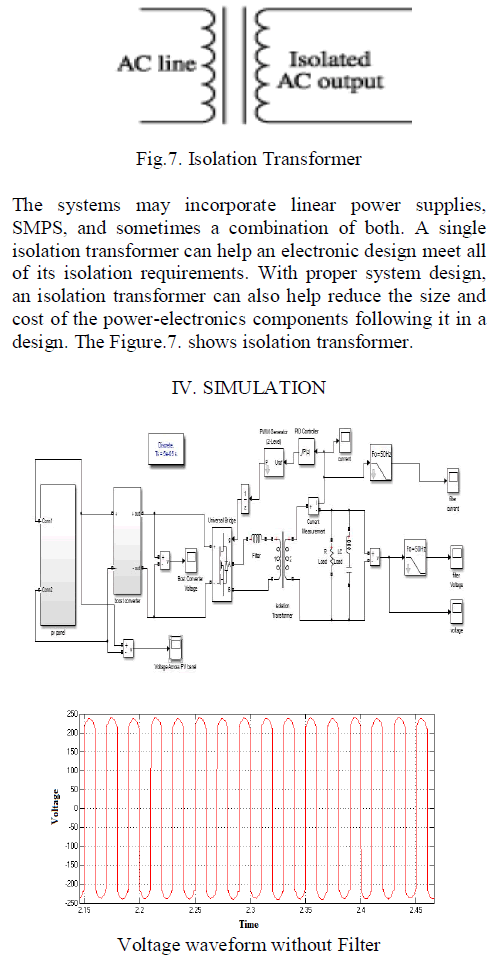 |
| Fig 1 and 2 shows the temperature distribution along conventional and concave solar still. |
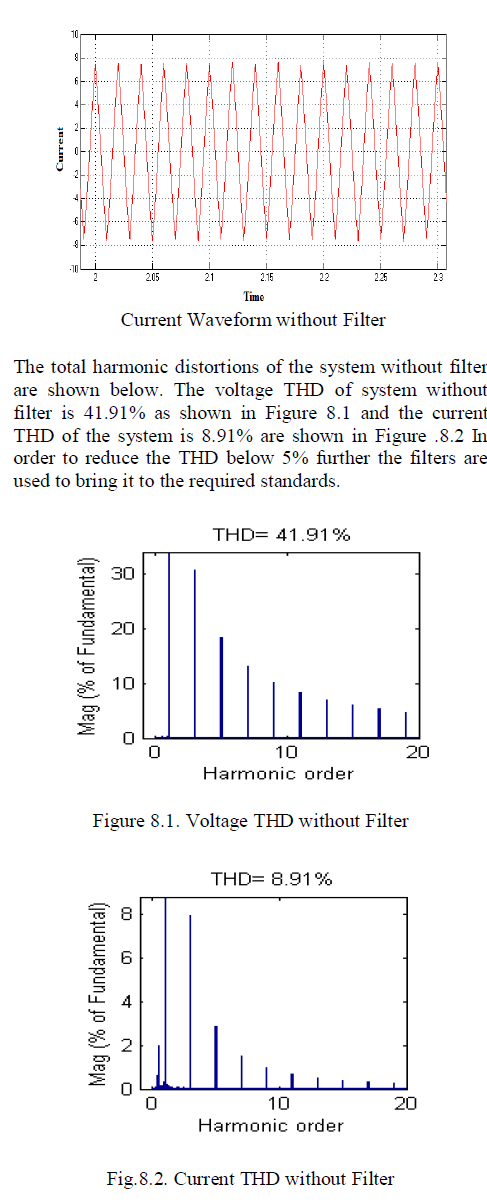 |
| PAPER 2 |
| In this review paper the pyramid type solar still is studied with or without fan within three days. The effect of air motion inside the solar still of 3m^2 area was studied exprementally by ali[1] air was allowed to circulate inside the still by placing a fan which consume negligible power , the results shows that the effect of forced convection inside the solarstill increase the productivity of the solar still due to turbulance which is created due to fan studied by ali et al[2,3], also it is notable that the productivity increases with increase in reynolds no. but it falls after maximum value. |
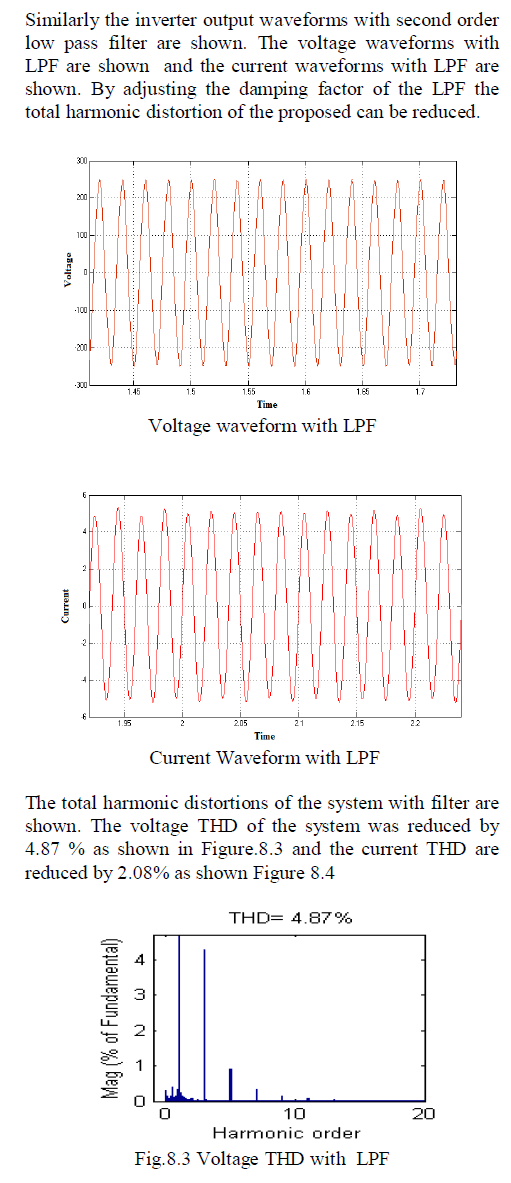 |
| It can be noted from Fig. 5 that the variation in solar radiation incident values during the three days of the testing is insignificant. For example, the maximum values of solar incident radiation around midday were around, 1000, 980 and 990W/m2 for the three days. Therefore, we predicate that the solar still efficiency would be close to the same value for three days. |
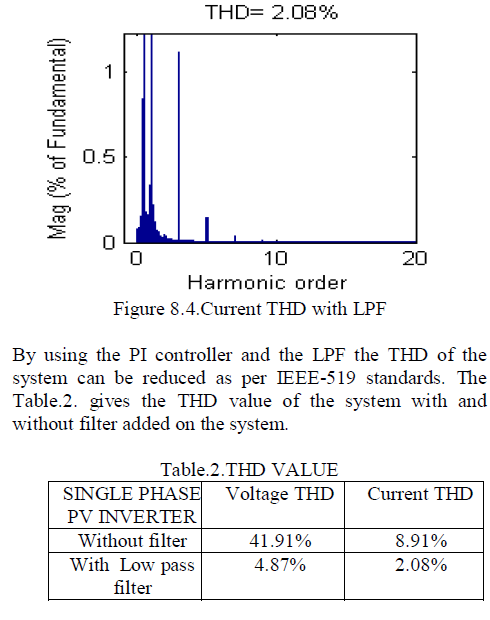 |
| Fig. 6.Hourly variation of saline water temperature(Tw),Glass cover temp(Tg),ambient temperature (Ta) |
| Fig. 6 shows the experimental results of the hourly variation of the saline water temperature, glass cover, and the ambient temperature during Day 1 of solar still testing. As shown, the temperature of saline water, glass cover and the ambient increases in the morning hours to reach maximum value around midday before it start to reduce late in the afternoon. It can be noted that the glass cover attains the maximum temperature faster than saline water. This is in fact because the saline water has higher thermal heat capacity than that of glass cover. |
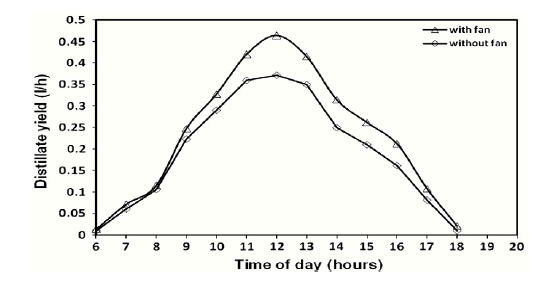 |
| Fig. 7 shows the hourly variation of freshwater production for solar still under forced and free convection effect. |
| Fig.7 shows that the daily freshwater production increases gradually to reach maximum value around midday and then decreases in the afternoon and matches the variation of solar radiation incident. The distillate production for natural and force convection was found to be 0.372 l and 0.464 l, respectively. This is mainly due to the existence of the fan that caused higher evaporation rate inside the still. The fan creates an amount of turbulence of the water vapor content of the air above the saline water that can take evaporated water vapor away from the saline water surface. |
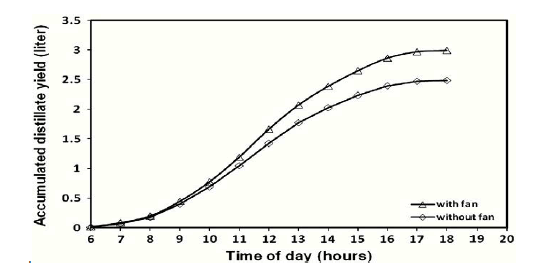 |
| Fig. 8 shows the comparative analyses of the freshwater production rate for solar still based on free and forced convection effect. |
| The fresh water production based on force convectionwas 2.99 l per day,whereas the experimental result based on free convection shows to be 2.485 l per day.The forced convection increases the productivity up to 25% due to circulating air inside and hence the evaporation rate that has been increased by the use of small power consumption fan. |
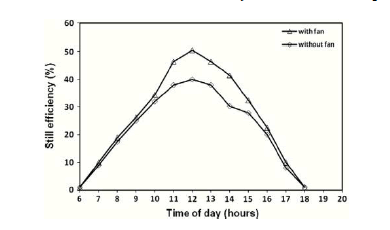 |
| Fig. 9 shows the hourly variation of the still efficiency for solar still based on free and force convection effect |
| It can be noted that the solar still efficiency increases in the morning time till reaching maximum value around midday and then decreases at slower rate in the afternoon. It is clear that the still efficiency profiles follow similar trends as of those for solar radiation and distillate yield as shown in Figs. 6 and 7. The maximum value of solar still efficiency based on free convection reached approximately 40.2%, whereas the experimental result based on forced convection shows to be 50.5%. Therefore, the forced convection has a significant effect on the distillate production. |
| PAPER 3 |
| In this paper performance of step wise basin is analysed with compare to traditional basin.The limitation of the traditional solar still is to produce less amount of distilled water per unit area. In the traditional solar still a top cover of 32âÃÂð made of glass with an interior surface made of a wooden proof membrane, exterior surfaces are painted black in order to increase the absorption of sun rays. |
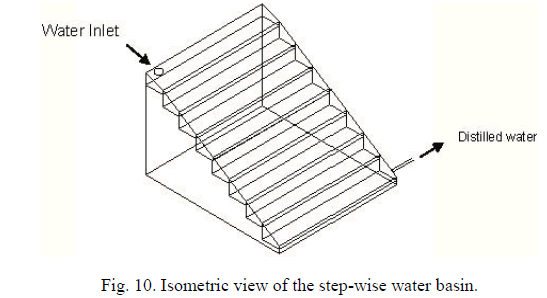 |
| In traditional solarstill basin size is 69.3×69.3×6.3 cm3.The arrangement is provided with the solar still which revolves the still from east to west with the help of spure gear and 36v dc motor. At mid-noon period the thermal losses are minimum and performance increase proportionally. The thermal efficiency of the stepwise |
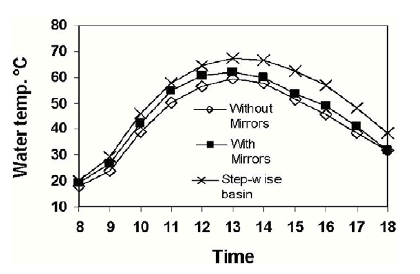 |
| Fig. 11. Water base temperature variations for traditional and modified solar still |
| basin is more than conventional basin because (1) a smaller volume trapped inside the still chamber then the traditional solar still so, heating up the trapped air will faster. (2) the step wise basin provides heigher heat & mass transfer surface area then the traditional still. After using reflecting mirrors 30% efficiency can be increase & by using step wise basin 180% efficiency can be increase. |
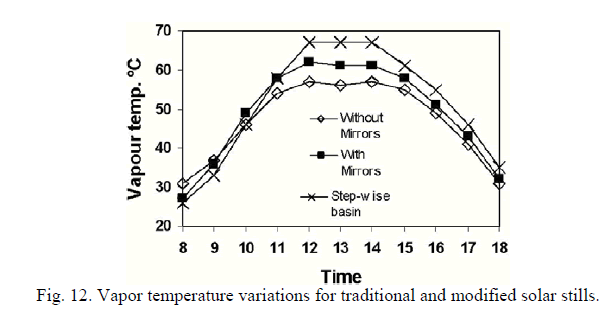 |
| Figs. 11 and 12 show an increase in the waterv temperature during early hours of the day until it reaches the maximum water temperature around mid-noon at the highest solar radiation, then decreases as the sun sets. These figures show that a wide temperature change was recorded. The water temperature was around 20EC early mornings, reaching up to 68EC as a maximum temperature at mid-noon. Therefore, at the mid-noon period, the thermal losses of the solar still were minimal, and the thermal performance increased proportionally. This is attributed to the increase of the surrounding ambient temperature of the still and higher solar radiation. The figures also show that installing internal side mirrors gave better performance because these mirrors make use of the energy reflected on all sides of the solar still. On the other hand, redesigning the flat water basin into a step-wise basin gave higher thermal performance than both with and without mirrors conventional stills. |
III. CONCLUSION |
| From this paper it is concluded that after reviewing all type of solar stills.By considering it is found that Stepwise Basin solar still gives much better as compared to all solar still discussed above because of its large absorbing area or basin area. The efficiency of stepwise Solar still is higher than concave and conventional Solar still. So, ascending order of efficiency of Solar still is [Conventional Solar still <Concave Solar still <Pyramid Solar still]. |
ACKNOWLEDGEMENT |
| Authors express their appreciation to Dr.Saurin Shah, Principal of Silver oak college of Engineering & Technology, Ahemdabad whom completed his M.Tech from IIT and Ph.D. from Nirma University, Ahemdabad, and Gujarat. |
References |
|